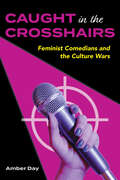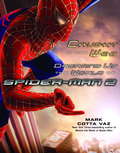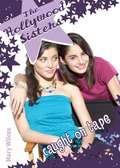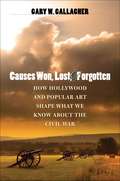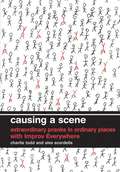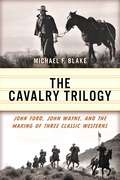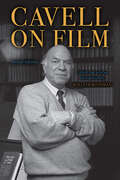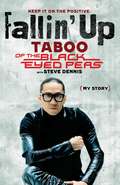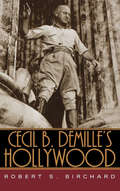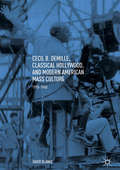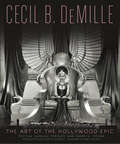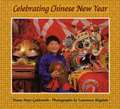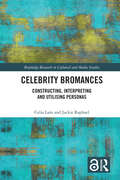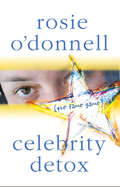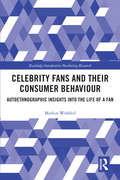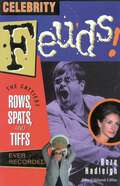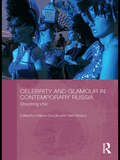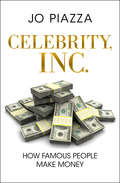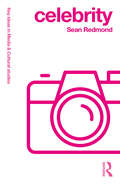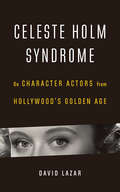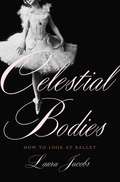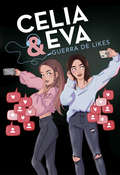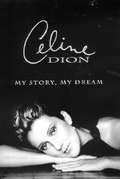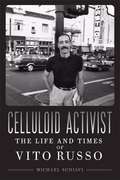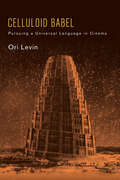- Table View
- List View
Caught in the Crosshairs: Feminist Comedians and the Culture Wars (Comedy & Culture)
by Amber DayThe landscape of comedy has undergone a seismic shift in recent years with an increasing number of female comedians breaking through to mainstream audiences. Women are claiming high-profile roles as late-night hosts, sketch comedians, television producers, and standup stars. As they disrupt industry norms and transgress cultural boundaries, they have also become lightning rods for controversy, eliciting flares of anger, amazement, revulsion, or hope.Caught in the Crosshairs delves not only into the work of feminist icons like Samantha Bee, Amy Schumer, Leslie Jones, Michelle Wolf, and Hannah Gadsby, but also into the discourse surrounding their comedy. Author Amber Day argues that these debates transcend mere entertainment; they are cultural battlegrounds for larger philosophical and political conflicts, interrogating ideals of gender, race, power, and public space. We see conflicts over what should be considered scandalous or beyond the pale, who should be in the intended audience, what is appropriate behavior for which performing bodies, and what the boundaries of comedy ultimately are. Caught in the Crosshairs is an examination of how feminist comedy reflects the tensions of our times, disrupting established narratives and challenging traditional power structures.
Caught in the Web: Dreaming up the World of Spider-Man 2
by Mark Cotta VazTheSpider-Man 2Dream Machine—from original idea to final cut— unmasking the creative genius at work in the blockbuster movie The epic adventure of one of the greatest superheroes of all time explodes on the silver screen as never before. Now, in this captivating journey behind the scenes and into the imagination, fans can discover how the myth and magic became real inSpider-Man 2, as they plunge deeper into Spider-Man’s world to meet the characters, explore the environments, and follow the storyline in a stunning visual journey. Packed with hundreds of amazing production illustrations, prepared by many of the most talented illustrators in Hollywood,Caught in the Webfeatures • Original sketches, artwork, and doodles that became the inspirations for characters, sets, and computer–generated imagery • Climactic scenes from the movie as they first appeared in conceptual art • Design work used to develop costumes and visual effects—as well as blueprints and architectural drafts used in the construction of both physical and virtual environments • Unique insights into the genesis of Doc Ock—revealing how he evolved from his comic-book origins • An intimate behind-the-scenes look at the full creative process forSpider-Man 2 Enter the amazing realm where dreams come true and discover how the epic adventure was created as you immerse yourself in the action and atmosphere ofSpider-Man 2, from the first rough sketches to the final on-screen adventure. From the Trade Paperback edition.
Caught on Tape (The Hollywood Sisters #3)
by Mary WilcoxJeremy :) Alex :( Heathcliff ? Now that we're living in Hollywood, Eva thinks anything is possible -- including casting the part of my boyfriend! As for the players: one's an actor (bad sign), one's a snobby rich kid (worse sign), and one doesn't even exist (stop sign). Guess who my sister picked?
Causes Won, Lost, and Forgotten
by Gary W. GallagherMore than 60,000 books have been published on the Civil War. Most Americans, though, get their ideas about the war--why it was fought, what was won, what was lost--not from books but from movies, television, and other popular media. In an engaging and accessible survey, Gary W. Gallagher guides readers through the stories told in recent film and art, showing how these stories have both reflected and influenced the political, social, and racial currents of their times.
Causing a Scene: Extraordinary Pranks in Ordinary Places with Improv Everywhere
by Charlie Todd Alex ScordelisImprov Everywhere has been responsible for some of the most original and subversive pranks of the Internet age.
Cavalry Trilogy: John Ford, John Wayne, and the Making of Three Classic Westerns
by Michael F. BlakeLike other filmmakers in post-WWII Hollywood, John Ford (already a three-time Best Directing Oscar winner), longed for the freedom and independence to make his own films, away from the dictates of studio executives. Then, in 1946, Ford and producer Merian C. Cooper (King Kong) decided to form their own production company, Argosy Productions. But their first venture was a financial flop, burdening the new company with heavy debt.Ford turned to the Western genre to help his flagging company, adapting James Warner Bellah&’s short story, &“Massacre.&” Fort Apache, released in 1948, starring John Wayne, Henry Fonda and Shirley Temple, was popular at the box office and with film critics.The following year, She Wore a Yellow Ribbon, was released to a positive critical reception a brisk business at the box office. This film was the only one in the cavalry trilogy shot in Technicolor, going on to win the Academy Award for Best Cinematography.Rio Grande (1950), the final film in the triad, was produced by Republic Pictures (the first of a three-picture deal with Argosy Productions) and marked the first pairing of John Wayne and Maureen O&’Hara. Because of the film&’s box office success, Republic Pictures greenlit Ford&’s dream project, The Quiet Man (1952).John Ford&’s cavalry trilogy is considered some of his finest work, although Ford always claimed he never intended to make a trilogy. The reality is the first two films were produced to financially help his company, while the final one served as a means to getting his dream project produced.The Cavalry Trilogy illuminates how each film was made, from pre-production to its theatrical release. Along the way, readers learn why Ford loved his favorite location (Monument Valley), how various stunts were achieved, and how Ford used his unique style in various scenes (called a &“Fordian touch&” by film critics and scholars). In addition, each film includes an analysis of Ford&’s scene construction and character development. Illustrated with numerous behind-the-scenes photographs, many which have never been published before, and screen captures from the cutting room floor, this book is the ultimate gift for John Ford fans and readers who love to discover the grit and glamour of Hollywood&’s Golden Age.
Cavell on Film (SUNY series, Horizons of Cinema)
by Stanley CavellA collection of the philosopher Stanley Cavell's most important writings on cinema.Stanley Cavell was the first philosopher in the Anglo-American tradition to make film a central concern of his work, and this volume offer a substantially complete retrospective of his writings on cinema, which continues to offer inspiration and new directions to the field of film and media studies. The essays and other writings collected here include major theoretical statements and extended critical studies of individual films and filmmakers, as well as occasional pieces, all of which illustrate Cavell's practice of film-philosophy as it developed in the decades following the publication of his landmark work, The World Viewed. This revised edition includes six additional essays, five of them previously unpublished, that illuminate his inspiring vision of a humanistic study rooted in a marriage of film and philosophy. In his introduction and in the preface to this new edition, William Rothman provides an overview of Cavell's work on film and his aims as a philosopher more generally.
Cayendo hacia arriba: Mi historia
by Taboo Steve DennisTaboo, el artista ganador de premios Grammy y cofundador de los Black Eyed Peas, comparte la historia inspiradora de su ascenso desde las calles duras del este de Los Ángeles a la cumbre de la fama internacional.Pocos grupos pueden desear el tipo de éxito global alcanzado por los Black Eyed Peas, batiendo récords y vendiendo más de treinta millones de discos desde su formación en 1995. Desde su disco The E.N.D., que debutó como #1 en la lista de éxitos de Billboard, a The Beginning, los Black Eyed Peas continúan dominando la escena musical. El grupo recientemente rompió el récord sin precedentes con la estadía consecutiva en la posición #1 del Hot 100 List de Billboard, y su canción "I Gotta Feeling" se transformó en el primer sencillo en superar las seis millones de descargas digitales en los Estados Unidos. Pero en esta reveladora autobiografía--el primer libro que surge del grupo--Taboo nos recuerda que los grandes logros muchas veces vienen de comienzos humildes.Nacido en el este de Los Ángeles, en una zona conocida por las pandillas y la pobreza, Taboo vivía atormentado por ese entorno, el cual parecía que seguro determinaría su destino. Pero, encaminado por sus sueños de ser artista al joven Taboo se le abrió todo un universo cuando descubrió el mundo del hip-hop, donde el talento y el amor por la música en sí trascendió todo. Apoyado por su abuela Aurora, su única y ver- dadera defensora, Taboo persiguió sus sueños con una tenacidad implacable. Se negó a darse por vencido, sin importar lo que la vida le arrojara en su camino--incluyendo el ser padre a los dieciocho años.Pero incluso después de que los Black Eyed Peas vencieron posibilidades que parecían insuperables y lograron el estrellato, no todo fue Grammys y discos platinos. Taboo entrega un relato mordazmente honesto sobre su choque con los demonios de la fama, incluyendo su lucha con la drogadicción y el alcoholismo que casi acaban con su carrera. Pero, inspirado por el amor de su familia y nuevamente conectándose con el manantial de creencia en sí mismo que lo había sostenido en el pasado, Taboo aprende a controlar sus demonios y sus adicciones.Repleto de vistazos íntimos a los alcances más altos de la industria de la música--incluyendo una visita al castillo de Sting, un rato pasado con Bono y U2 y, a 41.000 pies, el karaoke de más alto vuelo nunca jamás--Cayendo hacia arriba lleva al lector por un viaje revelador y personal a través del estrellato, y el triunfo de un hombre sobre el doble de la adversidad.
Cecil B. DeMille's Hollywood
by Robert S. BirchardA look at the wide-ranging work of the Golden Age genius who made The Ten Commandments and other blockbusters—and helped found the American film industry. Cecil B. DeMille&’s Hollywood is a detailed and definitive chronicle of the director&’s screen work that changed the course of film history—and a fascinating look at how movies were actually made in Hollywood&’s Golden Age. Drawing extensively on DeMille&’s personal archives and other primary sources, Robert S. Birchard offers a revealing portrait of DeMille the filmmaker that goes behind studio gates and beyond DeMille&’s legendary persona. In his forty-five-year career DeMille&’s box-office record was unsurpassed, and his swaggering style established the public image for movie directors. He had a profound impact on the way movies tell stories, and brought greater attention to the elements of decor, lighting, and cinematography. Best remembered today for screen spectacles such as The Ten Commandments and Samson and Delilah, DeMille also created Westerns, realistic &“chamber dramas,&” and a series of daring and highly influential social comedies—while setting the standard for Hollywood filmmakers and demanding absolute devotion to his creative vision from his writers, artists, actors, and technicians. &“Far and away the best film book published so far this year.&” —National Board of Review
Cecil B. DeMille, Classical Hollywood, and Modern American Mass Culture: 1910-1960
by David BlankeThis book uses the long and profitable career of Cecil B. DeMille to track the evolution of Classical Hollywood and its influence on emerging mass commercial culture in the US. DeMille’s success rested on how well his films presumed a broad consensus in the American public—expressed through consumer hedonism, faith, and an “exceptional” national history—which merged seamlessly with the efficient production methods developed by the largest integrated studios. DeMille’s sudden mid-career shift away from spectator perversity to corporate propagandist permanently tarnished the director’s historical standing among scholars, yet should not overshadow the profound links between his success and the rise and fall of mid-century mass culture.
Cecil B. DeMille: The Art of the Hollywood Epic
by Cecilia de Mille Presley Mark A. Vieira Introduction by Martin Scorsese Foreword by Brett RatnerColossal. Stupendous. Epic. These adjectives, used by movie companies to hawk their wares, became clichés long ago. When used to describe the films of one director, they are accurate. More than any filmmaker in the history of the medium, Cecil B. DeMille mastered the art of the spectacle. In the process, he became a filmland founder. One hundred years ago, he made the first feature film ever shot in Hollywood and went on to become the most commercially successful producer-director in history. DeMille told his cinematic tales with painterly, extravagant images. The parting of the Red Sea in The Ten Commandments was only one of these. There were train wrecks (The Greatest Show on Earth); orgies (Manslaughter); battles (The Buccaneer); Ancient Rome (The Sign of the Cross); Ancient Egypt (Cleopatra); and the Holy Land (The Crusades). The best of these images are showcased here, in Cecil B. DeMille: The Art of the Hollywood Epic. This lavish volume opens the King Tut’s tomb of cinematic treasures that is the Cecil B. DeMille Archives, presenting storyboard art, concept paintings, and an array of photographic imagery. Historian Mark A. Vieira writes an illuminating text to accompany these scenes. Cecilia de Mille Presley relates her grandfather’s thoughts on his various films, and recalls her visits to his sets, including the Egyptian expedition to film The Ten Commandments. Like the director’s works, Cecil B. DeMille: The Art of the Hollywood Epic is a panorama of magnificence--celebrating a legendary filmmaker and the remarkable history of Hollywood.
Celebrating Chinese New Year
by Diane Hoyt-GoldsmithTen-year-old Ryan Leong and his family are busy getting ready to host a huge New Year's Day dinner for their extended family in San Francisco's Chinatown. In eye-catching photographs and spirited prose, this book offers a look into the celebration of cherished traditions with added contemporary touches.
Celebrity Bromances: Constructing, Interpreting and Utilising Personas (Routledge Research in Cultural and Media Studies)
by Celia Lam Jackie RaphaelThis comprehensive work presents a thorough exploration of celebrity ‘bromances,’ interrogating how bromances are portrayed in media and consumed by audiences to examine themes of celebrity persona, performativity, and authenticity. The authors examine how the performance of intimate male friendships functions within broadly ‘Western’ celebrity culture from three primary perspectives: construction of persona; interactions with audiences and fans; and commodification. Case studies from film and television are used to illustrate the argument that, regardless of their authenticity (real or staged), bromances are useful for engaging audiences and creating an extension of entertainment beyond the film the actors originally sought to promote. The first truly interdisciplinary study of its kind, this book will be of great interest to scholars and students of communications, advertising, marketing, Internet studies, media, journalism, cultural studies, and film and television.
Celebrity Detox (The Fame Game): (the fame game)
by Rosie O'DonnellSometimes funny, sometimes heartbreaking, and always brutally honest, this is Rosie O'Donnell's surprising account of the pain, regret, and euphoria involved in withdrawing from celebrity life--and the terrifying dangers of relapsing into the spotlight. Celebrity Detox is Rosie's story of the years after she walked away from her top-rated TV show in 2002, and her reasons for going back on the air in 2006. In it, she takes you inside the world of talk-show TV, speaking candidly about the conflicts and challenges she faced as cohost on ABC's The View . Along the way Rosie shows us how fame becomes addiction and explores whether or not it's possible for an addict to safely, and sanely, return to the spotlight. Chronicling the ups and downs of "the fame game," Rosie O'Donnell illuminates not only what it's like to be a celebrity, but also what it's like to be a mother, a daughter, a leader, a friend, a sister, a wife...in short, a human being.
Celebrity Fans and Their Consumer Behaviour: Autoethnographic Insights into the Life of a Fan (Routledge Interpretive Marketing Research)
by Markus WohlfeilEver since the dawn of the Hollywood star system in the early 1920s, consumers have been fascinated by film stars and other celebrities and their seemingly glamorous private lives. The public demand for celebrities has become so pervasive that it is arguably an essential element of our everyday culture and market economy, and the focus of increasing study. This book explores the widespread phenomenon of celebrity fandom and provides a deeper understanding of why individual consumers develop an emotional attachment to their favourite celebrity and what this parasocial fan relationship means in their life. Based on an in-depth insider study of a consumer’s fan relationship with a film actress, the book provides unique insights into the celebrity-fan relationship, revealing the meaning it has for the consumer in everyday life, and how it evolves and expresses itself over time. While this book is primarily located within the field of consumer research, fandom and celebrity are of interest to a variety of academic disciplines. It will appeal to an interdisciplinary audience from marketing and consumer research, film studies, media studies, cultural studies, and sociology.
Celebrity Feuds!: The Cattiest Rows, Spats, and Tiffs Ever Recorded
by Boze HadleighCelebrity Feuds! dishes the dirt with in-depth stories of every word uttered, letter written, or fist swung from the cantankerous stars' first calamitous encounters to their deathbed declarations. Exposing the shocking tactics of the most bitter rivals in the entertainment industry and the vindictive, unseen ire of our favorite stars, this book reveals Hollywood with all its claws bared.
Celebrity and Glamour in Contemporary Russia: Shocking Chic (BASEES/Routledge Series on Russian and East European Studies)
by Helena GosciloThis is the first book to explore the phenomenon of glamour and celebrity in contemporary Russian culture, ranging across media forms, disciplinary boundaries and modes of inquiry, with particular emphasis on the media personality. The book demonstrates how the process of ‘celebrification’ in Russia coincides with the dizzying pace of social change and economic transformation, the latter enabling an unprecedented fascination with glamour and its requisite extravagance; how in the 1990s and 2000s, celebrities - such as film or television stars - moved away from their home medium to become celebrities straddling various media; and how celebrity is a symbol manipulated by the dominant culture and embraced by the masses. It examines the primacy of the visual in celebrity construction and its dominance over the verbal, alongside the interdisciplinary, cross-media, post-Soviet landscape of today’s fame culture. Taking into account both general tendencies and individual celebrities, including pop-diva Alla Pugacheva and ex-President and current Prime Minister Vladimir Putin, the book analyses the internal dynamics of the institutions involved in the production, marketing, and maintenance of celebrities, as well as the larger cultural context and the imperatives that drive Russian society’s romance with glamour and celebrity.
Celebrity, Inc.: How Famous People Make Money
by Jo PiazzaFrom $10,000 tweets to making money in the afterlife, a recovering gossip columnist explores the business lessons that power the Hollywood Industrial Complex Why do celebrities get paid so much more than regular people to do a job that seems to afford them the same amount of leisure time as most retirees? What do Bush-era economics have to do with the rise of Kim Kardashian? How do the laws of supply and demand explain why the stars of Teen Mom are on the cover of Us Weekly? And how was the sale of Brad Pitt and Angelina Jolie&’s baby pictures a little like a street drug deal? After a decade spent toiling as an entertainment journalist and gossip columnist, Jo Piazza asks the hard questions about the business behind celebrity. Make no mistake: Celebrity is an industry. Never in the course of human history has the market for celebrities been as saturated as it is today. Nearly every day most Americans will consume something a celebrity is selling—a fragrance, a sneaker, a song, a movie, a show, a tweet, or a photo in a magazine. With the benefits of Piazza&’s unique access to the celebrity market, Celebrity, Inc. explains in detail what generates cash for the industry and what drains value faster than a starlet downs champagne—in twelve fascinating case studies that tackle celebrities the way industry analysts would dissect any consumer brand.
Celebrity: New Directions In Celebrity Culture (Key Ideas in Media & Cultural Studies)
by Sean RedmondCelebrity introduces the key terms and concepts, dilemmas and issues that are central to the study and critical understanding of celebrity. Drawing on two dynamic models from two different modes of enquiry – the circuit of celebrity culture and the circuit of celebrity affect – this book explores the multi-layered, multi-faceted contexts and concepts that sit within and surround the study of celebrity. Through building a critical story about celebrity, Sean Redmond discusses key topics such as identity and representation; the celebrity body; the consumption of celebrity and celebrity culture; and the sensory connection between fans and celebrities, gender, activism, gossip and toxicity. Including case studies on Miley Cyrus, David Bowie, Scarlett Johansson and Kate Winslet, Celebrity is a dynamic and topical volume ideal for students and academics in celebrity and cultural studies.
Celeste Holm Syndrome: On Character Actors from Hollywood's Golden Age
by David LazarIn this essay collection David Lazar looks to our intimate relationships with characters, both well-known and lesser known, from Hollywood&’s Golden Age. Veering through considerations of melancholy and wit, sexuality and gender, and the surrealism of comedies of the self in an uncanny world, mixed with his own autobiographical reflections of cinephilia, Lazar creates an alluring hybrid of essay forms as he moves through the movies in his mind. Character actors from the classical era of the 1930s through the 1950s including Thelma Ritter, Oscar Levant, Martin Balsam, Nina Foch, Elizabeth Wilson, Eric Blore, Edward Everett Horton, and the eponymous Celeste Holm all make appearances in these considerations of how essential character actors were, and remain, to cinema.
Celestial Bodies: How to Look at Ballet
by Laura JacobsA distinguished dance critic offers an enchanting introduction to the art of balletAs much as we may enjoy Swan Lake or The Nutcracker, for many of us ballet is a foreign language. It communicates through movement, not words, and its history lies almost entirely abroad--in Russia, Italy, and France. In Celestial Bodies, dance critic Laura Jacobs makes the foreign familiar, providing a lively, poetic, and uniquely accessible introduction to the world of classical dance. Combining history, interviews with dancers, technical definitions, descriptions of performances, and personal stories, Jacobs offers an intimate and passionate guide to watching ballet and understanding the central elements of choreography.Beautifully written and elegantly illustrated with original drawings, Celestial Bodies is essential reading for all lovers of this magnificent art form.
Celia y Eva: Guerra de Likes
by Celia Dail Eva IbáñezEl libro de las musical.ly más potentes del momento. Una novela repleta de amor, amistad y un pequeño gran misterio por resolver. ¡Ah! Y por supuesto, todo ello envuelto con mucha música. <P><P>Eva y Celia no se conocen, pero tienen sueños muy parecidos. A las dos les encanta la música, la moda y son muy activas en redes sociales. <P>Aunque sus canales no terminan de despegar del todo, se imaginan compartiendo sus canciones, sus gustos y sus inquietudes con miles de seguidores. Un día, sus destinos y sus voces se cruzan por casualidad en una parada de autobús. La cámara de un móvil graba el momento y lo que tanto tiempo han querido se convierte en realidad. <P>Amistad, seguidores, popularidad... ¡Lo tienen todo! <P>Pero justo en lo mejor del sueño, dos chicos misteriosos empiezan a hacerles sombra. ¿Quiénes son, y qué quieren esos dos imitadores que amenazan con arrebatarles seguidores? <P>A Eva y Celia les ha costado mucho llegar donde están, y están dispuestas a defenderlo de quien sea y como sea... ... aunque para ello tengan que librar una auténtica guerra de likes.
Celine Dion: My Story, My Dream
by Celine Dion Bruce Benderson Georges-Hébert GermainNow, in her own words, the most dynamic vocal talent of our time--the international singing sensation whose recordings have sold millions, and whose performances electrify the world's great arenas--gives us her poignant, intimate, and inspiring life story . . . from the heart. She was born into a working-class Canadian family, the youngest of fourteen children. She gave her first performance standing on a kitchen table and dreamed of becoming a superstar. Few in her field can rival the phenomenal God-given abilities of Celine Dion. Fewer still have experienced the love, sorrow, accomplishment, and ecstasy that have shaped her remarkable life and carried her to the pinnacle of the entertainment world. "In Celine Dion: My Story, My Dream Celine takes us backstage, on the road, into the recording studio, and behind the scenes to reveal the hard work that creates the magic. But her book, much more than a chronicle of early breakthroughs and professional high-water marks, of unforgettable encounters with the luminaries and legends of show business is, first and foremost, a story of love. This talented and beautiful woman who has moved us with her singing now moves us with her words as she tells of growing up in a large, close-knit household fortified in its daily struggles by powerful bonds of heartfelt affection and the family tragedies their shared love enabled them to overcome. Here, also, Celine recounts warmly and intimately the storybook romance that remains her most enduring passion and greatest joy: Celine's marriage to René Angélil, her manager and soul mate. She tells of the devastating pain they both experienced when a doctor informed them that René had cancer, and how fighting the disease together helped strengthen their relationship. And she shares her joy, anxiety, and breathless anticipation of the impending fulfillment of their most cherished dream: parenthood. A true story of courage, perseverance, dedication, and devotion--told with the wide-eyed honesty of someone who, though she has basked in the glowing adoration of millions of fans, has never lost touch with her working-class roots--Celine Dion: My Story, My Dream is for anyone who has ever wondered about the real person behind the magnificent voice. Touching and funny, fascinating and uplifting, it is an exquisitely detailed portrait of a remarkable woman who has never backed away from a challenge ... even the most daunting challenges of the heart. CELINE DION is one of the world's most popular and well-known singers today. When she sang at the opening ceremonies of the Olympic Games in Atlanta, her voice reached 3.5 billion people worldwide. Her albums are instant bestsellers upon release. She has sold more than 60 million copies of her English-language recordings, millions more of her French recordings, and 18 million copies of "My Heart Will Go On," the theme from Titanic. Celine is admired and loved by fans around the world, and her concerts fill stadiums, whatever the size. With 115 separate music awards to her name, she is a living legend.
Celluloid Activist: The Life and Times of Vito Russo
by Michael SchiaviCelluloid Activist is the biography of gay-rights giant Vito Russo, the man who wrote The Celluloid Closet: Homosexuality in the Movies, commonly regarded as the foundational text of gay and lesbian film studies, and one of the first to be widely read. But Russo was much more than a pioneering journalist and author. A founding member of the Gay and Lesbian Alliance Against Defamation (GLAAD) and cofounder of the AIDS Coalition to Unleash Power (ACT UP), Russo lived at the center of the most important gay cultural turning points in the 1960s, 1970s, and 1980s. His life as a cultural Zelig intersects a crucial period of social change, and in some ways his story becomes the story of a developing gay revolution in America. A frequent participant at "zaps" and an organizer of Gay Activists Alliance (GAA) cabarets and dances-which gave the New York gay and lesbian community its first social alternative to Mafia-owned bars-Russo made his most enduring contribution to the GAA with his marshaling of "Movie Nights," the forerunners to his worldwide Celluloid Closet lecture tours that gave gay audiences their first community forum for the dissection of gay imagery in mainstream film. Biographer Michael Schiavi unravels Vito Russo's fascinating life story, from his childhood in East Harlem to his own heartbreaking experiences with HIV/AIDS. Drawing on archival materials, unpublished letters and journals, and more than two hundred interviews, including conversations with a range of Russo's friends and family from brother Charlie Russo to comedian Lily Tomlin to pioneering activist and playwright Larry Kramer,Celluloid Activist provides an unprecedented portrait of a man who defined gay-rights and AIDS activism.
Celluloid Babel: Pursuing a Universal Language in Cinema (SUNY series, Horizons of Cinema)
by Ori LevinTraces the intellectual history of cinema's aspiration to create a universal language, examining how this vision has been articulated in both writings and films.Celluloid Babel offers a transnational intellectual history of cinema's quest for universal language, unfolding through both writings and films. Today, algorithms and data-collection systems play a significant role in predicting the viewer's preferences and suggesting content specifically tailored to their particular interests. However, this promise of on-demand personalized media is markedly different from the promise outlined in cinema's initial promotional discourse, which celebrated the medium’s ability to appeal to a universal audience. Instead of targeting fragmented audiences, cinema was supposed to captivate and engage everyone all at once, regardless of social station, educational level, or national affiliation. The aspiration for a universal language left an indelible mark on film history, yet despite its significance, the history and theory behind it remain largely unexplored. Celluloid Babel illuminates a pivotal chapter in early film theory and establishes it as the inaugural paradigm of thought on cinema’s nature. By exploring this pursuit, the book reveals the forgotten utopian potential of mass media and uncovers complex correlations among political ideals, aesthetic preferences, material conditions, modes of spectatorship, and governance.
